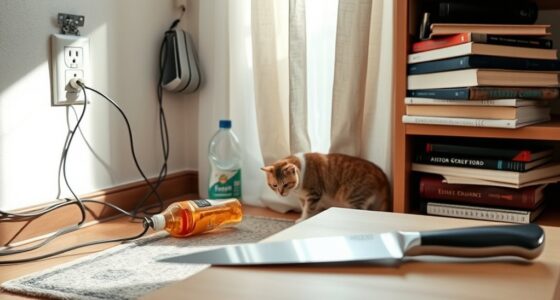To clear clutter and reduce trip hazards, start by identifying hotspots like hallways, entryways, and uneven surfaces. Use storage bins and labels to organize items efficiently, and keep pathways clear by removing unnecessary or misplaced objects. Regularly assess your space, involve others if needed, and guarantee safety checks are done afterward. Staying consistent with these habits will help create a safer, clutter-free environment—keep exploring for more helpful tips.
Key Takeaways
- Regularly evaluate and organize cluttered areas like entryways, living rooms, and kitchens to prevent obstacles and hazards.
- Use clear storage bins, labels, and vertical solutions to keep items accessible and reduce trip risks.
- Maintain pathways free of debris, cords, and misplaced objects to ensure safe movement throughout the space.
- Schedule routine decluttering sessions to prevent accumulation of seasonal decorations and miscellaneous items.
- Conduct post-cleaning safety checks to secure loose items, verify clear exits, and eliminate potential trip hazards.
Recognizing Common Clutter Hotspots
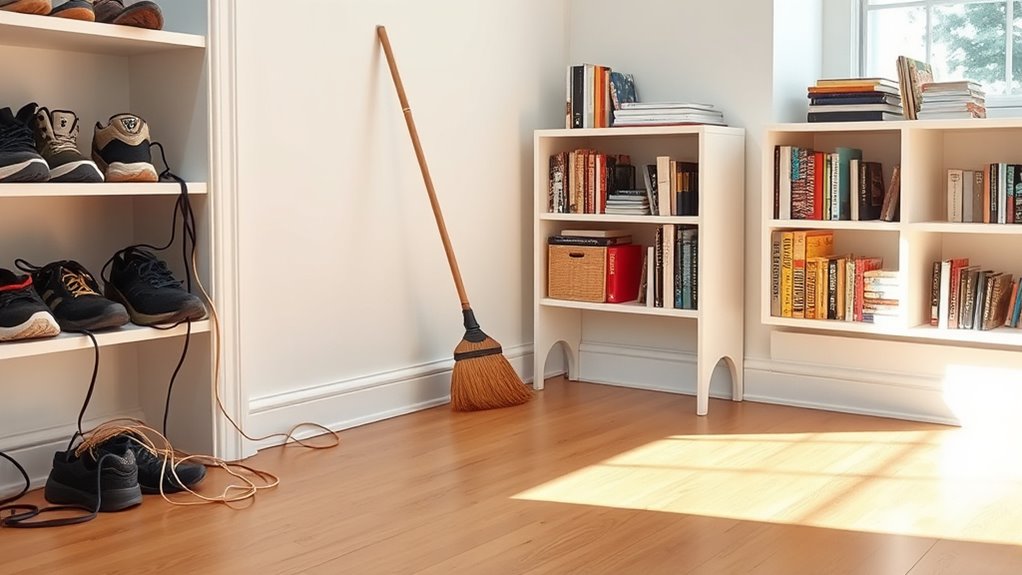
Many clutter hotspots tend to develop in everyday areas where items quickly accumulate, often without you noticing. These spots often include living rooms, entryways, and kitchens, where clutter from decorating styles and seasonal decorations pile up. For example, seasonal decorations like holiday ornaments or summer-themed decor can clutter tabletops or closets if not stored properly. Decorating styles influence how clutter builds; eclectic or maximalist styles may result in more items scattered around, while minimalist designs tend to keep clutter at bay. Recognizing these hotspots helps you identify where clutter tends to gather unnoticed. Being aware of the decorative elements that contribute to clutter can help you develop strategies to manage and organize these items more effectively. By paying attention to these areas, you can prevent clutter from becoming overwhelming, making your space safer, cleaner, and more organized.
The Impact of Clutter on Safety

Clutter can substantially compromise your safety by creating obstacles and increasing the risk of accidents. It can cause trips and falls, leading to injuries, especially in busy or dimly lit areas. Additionally, clutter can heighten fire hazards by blocking exits or cluttering electrical outlets, making emergencies more dangerous. The presence of clutter also impacts your emotional well-being, causing stress and anxiety from a chaotic environment. To keep your space safe, consider these points:
- Removing tripping hazards like loose cords or scattered objects
- Ensuring pathways are clear for quick evacuation
- Reducing clutter to prevent fire risks and promote a calming environment
- Paying attention to the contrast ratio of your lighting and decor to improve visibility and safety
Addressing clutter not only minimizes physical dangers but also enhances your overall sense of safety and peace of mind.
Essential Tools for Decluttering
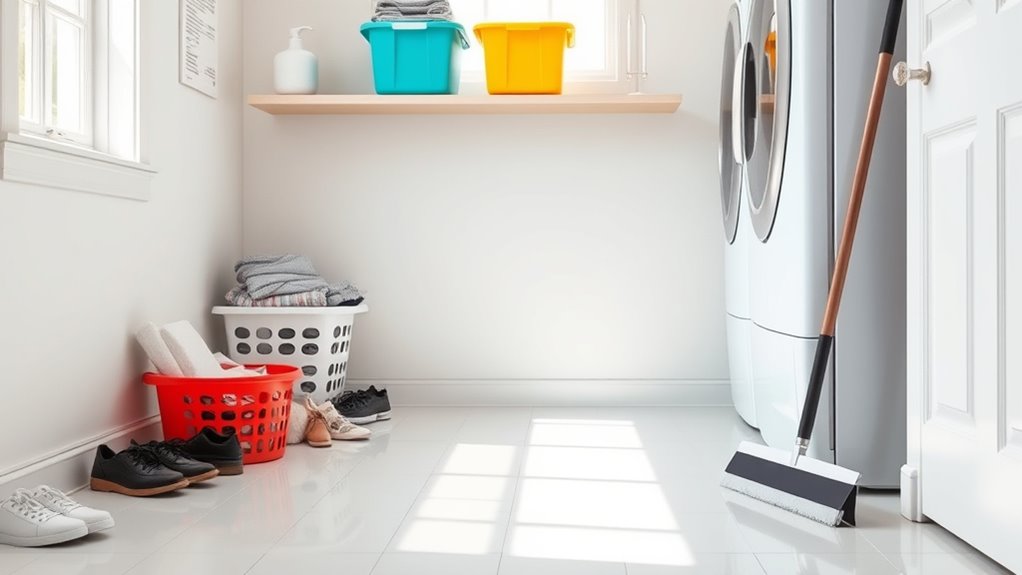
To effectively declutter your space, having the right tools on hand is essential. Storage bins are perfect for organizing items and keeping clutter out of sight, making your area safer and more navigable. Choose clear bins so you can easily see what’s inside, saving time and reducing frustration. Label makers are equally important; they help you identify the contents of each bin quickly, preventing unnecessary digging through piles. Clear labels also promote consistency and make future tidying easier. Invest in sturdy containers and a reliable label maker to streamline your decluttering process. These tools not only help you sort and store belongings efficiently but also create a cleaner, safer environment by reducing trip hazards. Proper organization is key to maintaining a clutter-free space. Additionally, incorporating celebrity home organization tips can inspire you to create a stylish and functional environment that minimizes hazards.
Step-by-Step Decluttering Strategies

Start by evaluating your space to spot any hazards that could cause injuries or damage. Next, sort your items and prioritize what needs immediate attention or can be discarded. Additionally, creating designated zones for specific items can help maintain organization and prevent clutter from reaccumulating. Finally, establish a routine to maintain your decluttered space and prevent clutter from piling up again.
Assess and Identify Hazards
Have you ever wondered how to effectively spot hazards hidden among your belongings? The key is thorough hazard identification and risk assessment. Start by carefully inspecting your space for potential trip hazards like loose rugs, cluttered walkways, or uneven surfaces. Look for items that could easily fall or obstruct pathways. Focus on areas where you or others frequently walk, and check for:
- Obstructed pathways or blocked exits
- Loose or unstable furniture and rugs
- Items stored at ankle level or on stairs
Ensuring proper shower base installation and secure fixtures can also prevent slips and falls in adjacent areas.
Sort and Prioritize Items
Once you’ve identified the hazards in your space, the next step is to sort and prioritize your items. Begin by gathering similar items together, such as tools, paperwork, or toys. Use storage containers to group these items neatly, making it easier to see what you have and what can be discarded or stored elsewhere. Apply labeling techniques to each container, clearly indicating its contents, so you can quickly find what you need and avoid unnecessary clutter. Prioritize items based on frequency of use; keep frequently used items in accessible spots and store infrequently used ones out of the way. This process helps create order, reduces clutter, and minimizes tripping hazards, making your space safer and more organized.
Implement Maintenance Routine
Establishing a consistent maintenance routine is essential for keeping your space decluttered over time. Regular checks prevent clutter from piling up and creating trip hazards. Use storage bins to organize items and label systems to guarantee everything has a designated spot. Schedule weekly or bi-weekly tidying sessions to put things back in order. During these routines, review storage bins for items that are no longer needed and discard or donate them. Keep labels visible and updated so you can quickly find or return items. This ongoing effort helps maintain a safe, clutter-free environment. Remember, small, consistent actions make a big difference in preventing clutter from accumulating and reducing trip hazards in your space. Incorporating routine cleaning into your schedule can also help detect potential hazards early before they become serious issues.
Organizing Storage Spaces Effectively

To organize your storage spaces effectively, start by categorizing your items systematically so everything has a clear place. Use vertical storage solutions to maximize space and keep things accessible. Make it a habit to regularly declutter these areas to prevent clutter from building up again. Incorporating storage solutions designed specifically for your space can further streamline organization and reduce hazards.
Categorize Items Systematically
Organizing storage spaces effectively begins with categorizing items systematically. You want to create clear groups to find what you need quickly and prevent clutter. Use consistent naming conventions and labeling systems to keep everything organized. For example, label boxes with specific names like “Holiday Decorations” or “Tools,” making retrieval easier. Consider grouping items by:
- Frequency of use (daily, occasional, rare)
- Function or purpose
- Size or shape for stacking efficiency
This approach helps you decide where to store items and ensures everything has a designated place. When labels are clear and consistent, it minimizes confusion and saves time. Incorporating efficient storage solutions can further optimize your space, making organization more effective. Systematic categorization keeps your space tidy and reduces the risk of trip hazards caused by misplaced or cluttered items.
Utilize Vertical Storage Solutions
After categorizing items systematically, you can maximize your storage space by utilizing vertical solutions. Installing hanging shelves allows you to keep frequently used items within easy reach while freeing up floor space. Use wall-mounted bins to organize smaller objects, such as tools, cleaning supplies, or accessories, keeping them off surfaces and reducing clutter. These vertical solutions help you make the most of your wall space, especially in tight areas. By stacking storage vertically, you prevent items from spilling into walkways or creating trip hazards. Confirm shelves and bins are securely mounted and labeled for easy identification. Proper storage organization practices ensure your items are accessible and reduce clutter, making your space safer and more organized without sacrificing valuable floor area.
Regularly Declutter Areas
Have you ever noticed how clutter quickly sneaks back into your space even after organizing? Regularly decluttering areas helps maintain a tidy environment and reduces trip hazards. Set aside time weekly to evaluate your storage spaces. Use storage containers to contain items and prevent messes. Implement label systems to identify contents easily, making it simple to find what you need and put things back in order. When decluttering, ask yourself if each item is still useful or necessary. Discard or donate items you no longer need. Keep high-traffic areas clear by maintaining organized storage solutions. This routine ensures your space stays safe and clutter-free, minimizing the risk of trips or falls. Consistency is key to long-term organization and safety.
Creating Clear Pathways and Walkways
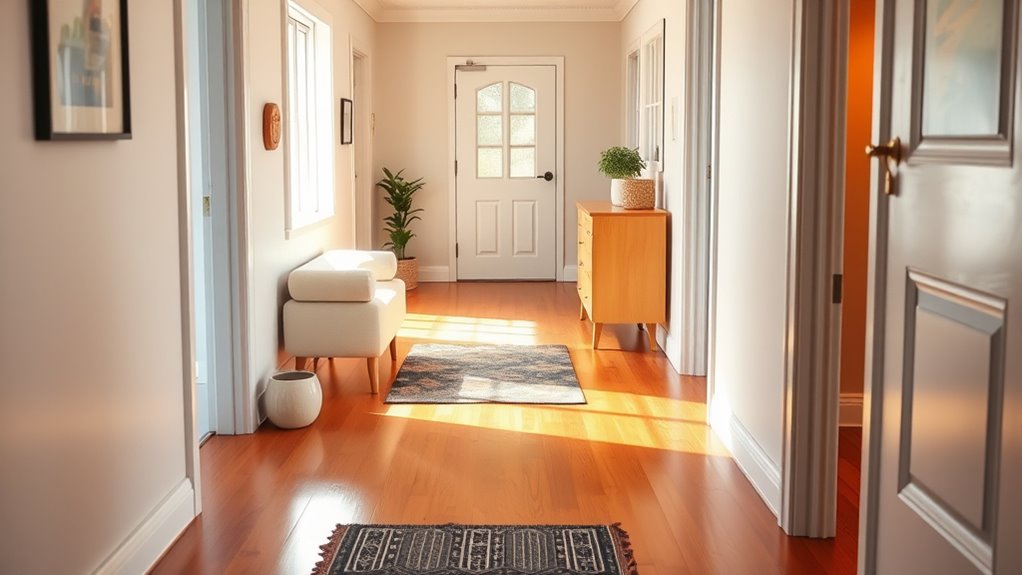
Creating clear pathways and walkways is essential for maintaining a safe and functional space. Start by removing clutter from hidden corners and clutter zones that may trap items out of sight. Guarantee walkways are free from obstacles, making it easy to move around safely. Use rugs or mats that won’t slip or cause tripping. Arrange furniture to create a natural flow, avoiding tight or awkward passages. Regularly check for debris or misplaced objects blocking your routes. Keep cords and cables tucked away to prevent tripping hazards. Clear pathways help you navigate quickly, especially in emergencies. By addressing hidden corners and clutter zones, you’ll create a safer environment where hazards are minimized, and everyday movement feels more comfortable and secure.
Maintaining a Clutter-Free Environment

To keep your space clutter-free, establish a regular decluttering schedule that fits your routine. Use proper storage solutions to organize items and prevent chaos from building up. Always keep pathways clear so your environment stays safe, functional, and easy to navigate.
Regular Decluttering Schedule
Establishing a regular decluttering schedule is essential for maintaining a clutter-free environment. Consistency helps you stay proactive with clutter reduction techniques, preventing clutter from building up and creating trip hazards. Set specific intervals—weekly or monthly—to review and tidy your space. During these sessions, focus on prioritizing storage optimization to clear pathways and reduce hazards. Consider these tips:
- Reassess your storage solutions to make items easier to access
- Discard or donate items you no longer need
- Organize belongings to keep essential areas clear and safe
Proper Storage Solutions
Have you ever wondered why some spaces stay organized even after decluttering? The key is proper storage solutions. Using storage bins helps you categorize and contain items, preventing clutter from spreading. Clear bins allow you to see contents at a glance, saving time and reducing frustration. Shelving units maximize vertical space, keeping frequently used items accessible while freeing up floor area. Label your storage bins for easy identification, so you know exactly where everything belongs. Invest in sturdy shelving to support heavier items safely. By organizing items into designated storage bins and utilizing shelving units, you create a system that’s easy to maintain. This approach keeps your environment tidy and safe, reducing trip hazards and making cleanup faster and more effective.
Clear Pathways Always
Keeping pathways clear is essential for a safe and efficient space. When you maintain a clutter-free environment, you reduce the risk of trips and falls. To achieve this, consider simple decorating ideas that prioritize open walking areas. Focus on furniture arrangement by placing larger pieces against walls and avoiding blocking doorways or hallways. Regularly check for items that can be moved or stored elsewhere. Here are some tips:
- Use multi-functional furniture with built-in storage
- Keep décor minimal to avoid obstruction
- Arrange furniture to create wide, unobstructed pathways
Tips for Involving Others in Decluttering

Getting others involved in decluttering can make the process faster and less overwhelming. To motivate others, explain how decluttering improves safety and creates a cleaner space. Highlight the benefits, like fewer trip hazards and easier maintenance. Assign responsibilities based on each person’s strengths; for example, one can handle sorting papers while another clears out clutter from shelves. Make the process collaborative by setting clear goals and timelines. Encourage teamwork by offering praise and small rewards for completing tasks. When everyone has a role, they’re more likely to stay engaged and motivated. Remember, involving others isn’t just about sharing the workload—it’s about creating a shared sense of responsibility that keeps the space safe and clutter-free longer.
Safety Checks After Decluttering
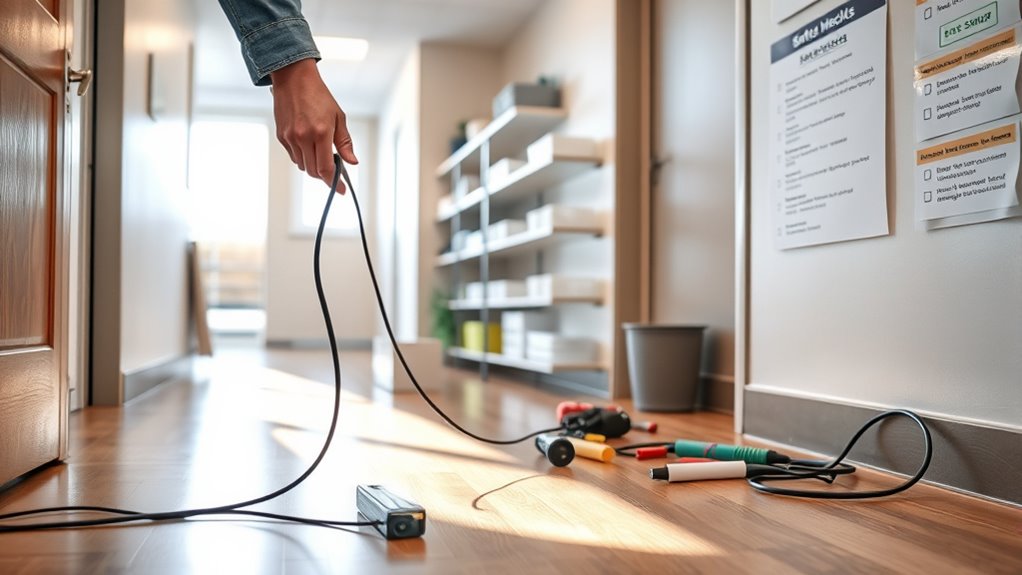
After you finish decluttering, it’s essential to conduct safety checks to prevent accidents and guarantee the space remains secure. Examine your area for loose or unstable items that could trip someone, especially around decorative accents and aesthetic arrangements. Ensure walkways are clear and free of obstructions. Check that any remaining decorative accents are securely placed and won’t fall or cause a hazard. Look for uneven surfaces or items that might shift underfoot.
Ensure walkways are clear, decorative accents are secured, and remove hazards for a safe, clutter-free space.
- Verify that pathways are unobstructed and smooth
- Confirm decorative accents are stable and properly secured
- Remove or reposition any items that could cause slips or trips
Performing these checks helps maintain a safe environment and preserves your efforts in decluttering, creating a space that’s both functional and visually appealing.
Long-Term Habits for a Safer Space

Have you established routines that promote ongoing safety in your space? Developing long-term habits helps keep clutter and trip hazards at bay. Prioritize decorating choices that emphasize safety, like clear walkways and accessible storage. Be mindful of emotional attachment to items; if something no longer serves a purpose, consider letting it go rather than letting it pile up. Regularly reassess your space to identify new hazards and ensure your habits are effective. Setting aside a few minutes weekly for tidying helps prevent clutter from building up again. These routines reinforce your commitment to a safer environment and make clutter management second nature. Over time, consistent habits will create a space that’s not only visually pleasing but also minimizes the risk of trips and falls.
Frequently Asked Questions
How Often Should I Reassess My Space for Potential Hazards?
You should perform regular inspections and hazard checks of your space at least once a month. This helps you identify any potential dangers early and keeps your environment safe. If you notice changes or new clutter, reassess more frequently. Staying proactive guarantees that trip hazards or other risks don’t develop unnoticed, creating a safer environment for everyone. Consistent hazard checks make it easier to maintain a clutter-free, hazard-free space.
Are There Specific Safety Standards for Clutter Removal in Homes?
Imagine a family avoiding falls by following basic home safety tips. While there aren’t strict clutter regulations, many organizations recommend keeping walkways clear and removing hazards. You should focus on maintaining a clutter-free environment to prevent trips. Although specific safety standards for clutter removal vary, regularly reassessing your space helps verify compliance with general home safety principles, reducing slip and trip risks and creating a safer living space for everyone.
How Can I Prevent Clutter From Accumulating Again After Decluttering?
To prevent clutter from building up again, focus on habit formation and establishing strong organizational habits. Make a daily routine of putting things away immediately and regularly reviewing your space to discard unnecessary items. Use storage solutions to keep things organized and accessible. Consistently practicing these habits helps maintain a clutter-free environment, reducing trip hazards and making your home safer and more comfortable over time.
What Are the Best Storage Solutions for Small or Limited Spaces?
In tight spaces, smart storage can make a world of difference. You’ll want to choose multi-functional furniture that serves dual purposes, like beds with built-in drawers or ottomans with hidden compartments. Vertical storage solutions are your best friends—they maximize space without cluttering. Think wall-mounted shelves or hanging organizers. These options help you keep essentials accessible while maintaining a tidy, organized environment, making even limited space feel open and functional.
How Do I Motivate Others to Participate in Decluttering Efforts?
You can motivate others to participate in decluttering by using motivational techniques like setting clear goals, offering rewards, or making it fun. Address participation challenges by understanding their concerns and involving them in decision-making. Show how a clutter-free space benefits everyone, making the effort feel more rewarding. Your enthusiasm and positive attitude will inspire others to join, making the process easier and more enjoyable for everyone involved.
Conclusion
So, next time you trip over that rogue shoe or stub your toe on a stray cord, remember—your clutter isn’t just a mess, it’s a silent accomplice. With a little effort, you can reclaim your space and keep yourself upright. Because, after all, avoiding a trip hazard is the only adventure you should be seeking at home. Stay vigilant, stay organized, and let clutter beware—your safety’s worth it.





